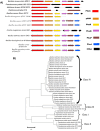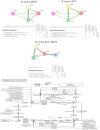Genomic analysis and potential polyhydroxybutyrate (PHB) production from Bacillus strains isolated from extreme environments in Mexico
- PMID: 39799315
- PMCID: PMC11724563
- DOI: 10.1186/s12866-024-03713-7
Genomic analysis and potential polyhydroxybutyrate (PHB) production from Bacillus strains isolated from extreme environments in Mexico
Abstract
Background: Plastic pollution is a significant environmental problem caused by its high resistance to degradation. One potential solution is polyhydroxybutyrate (PHB), a microbial biodegradable polymer. Mexico has great uncovered microbial diversity with high potential for biotechnological applications. The best polymer producers tend to be isolated from environments that require survival adaptations from microorganisms, the high-producing Bacillus cereus strain saba.zh comes from refinery wastewater, the costs of production have been a limiting factor for biopolymer production, and one of the focuses of interest has been finding novel strains with better production or singular traits that help in industrial processes.
Results: The isolates were taxonomically classified as Bacillus cereus MSF4 and Bacillus inaquosorum MSD1 from Mina, Nuevo Leon; B. cereus S07C; and Paenibacillis dendritiformis from the active volcano "El Chichonal" on Chiapas. The strains had growth temperatures ranging from 35 to 50 °C and pH tolerance values ranging from 3 to 9. The best PHB-producing strain, B. cereus MSF4, produced 0.43 g/kg PHB on orange peels, followed by B. inaquosorum MSD1 at 0.40 g/kg, B. cereus S07C at 0.23 g/kg and P. dendritiformis at 0.26 g/kg.
Conclusions: The findings of this study affirm the potential of the Mexican isolated strains as PHB-producing organisms, enabling further studies to test their viability as industrial producers. The ability of P. dendritiformis and B. inaquosorum to synthetize PHB was also confirmed by the observations made providing novel evidence to consider these species as potential producers.
Keywords: Bacillus i naquosorum; Bacillus cereus; Paenibacillus dendritiformis; Dry cell weight; Genome; Phylogeny; Polyhydroxybutyrate (PHB); YteA.
© 2024. The Author(s).
Conflict of interest statement
Declarations. Ethics approval and consent to participate: Not applicable. Consent for publication: Not applicable. Competing interests: The authors declare no competing interests.
Figures










Similar articles
-
Bacillus cereus saba.zh, a novel bacterial strain for the production of bioplastic (polyhydroxybutyrate).Braz J Microbiol. 2021 Dec;52(4):2117-2128. doi: 10.1007/s42770-021-00599-9. Epub 2021 Sep 12. Braz J Microbiol. 2021. PMID: 34510397 Free PMC article.
-
Cost-effective-substrates for production of poly-β-hydroxybutyrate by a newly isolated Bacillus cereus PS-10.J Environ Biol. 2015 Nov;36(6):1297-304. J Environ Biol. 2015. PMID: 26688964
-
Screening of the strictly xylose-utilizing Bacillus sp. SM01 for polyhydroxybutyrate and its co-culture with Cupriavidus necator NCIMB 11599 for enhanced production of PHB.Int J Biol Macromol. 2021 Jun 30;181:410-417. doi: 10.1016/j.ijbiomac.2021.03.149. Epub 2021 Mar 26. Int J Biol Macromol. 2021. PMID: 33775761
-
Functionalisation of polyhydroxybutyrate for diagnostic uses.N Biotechnol. 2025 Mar 25;85:9-15. doi: 10.1016/j.nbt.2024.11.002. Epub 2024 Nov 15. N Biotechnol. 2025. PMID: 39549939 Review.
-
Critical overview of biomass feedstocks as sustainable substrates for the production of polyhydroxybutyrate (PHB).Bioresour Technol. 2020 Sep;311:123536. doi: 10.1016/j.biortech.2020.123536. Epub 2020 May 18. Bioresour Technol. 2020. PMID: 32448640 Review.
References
-
- GrandviewResearch. Polyhydroxybutyrate-co-hydroxyvalerate Market Size, Share & Trends Analysis Report By Waste Type, Application, By Region, And Segment Forecasts, 2023 To 2030. Retrieved from https://www.grandviewresearch.com/industry-analysis/polyhydroxybutyrate-...
-
- Venkatesh S, Mahboob S, Govindarajan M, Al-Ghanim KA, Ahmed Z, Al-Mulhm N et al. Microbial degradation of plastics: Sustainable approach to tackling environmental threats facing big cities of the future. Vol. 33, Journal of King Saud University - Science. Elsevier B.V.; 2021. Available from:10.1016/j.jksus.2021.101362
-
- Hartmann NB, Hüffer T, Thompson RC, Hassellöv M, Verschoor A, Daugaard AE et al. Are We Speaking the Same Language? Recommendations for a Definition and Categorization Framework for Plastic Debris. Environ Sci Technol. 2019;53(3):1039–47. Available from:10.1021/acs.est.8b05297 - PubMed
-
- Zou H, Shi M, Zhang T, Li L, Li L, Xian M. Natural and engineered polyhydroxyalkanoate (PHA) synthase: key enzyme in biopolyester production. Vol. 101, Applied Microbiology and Biotechnology. Springer Verlag; 2017. pp. 7417–26. Available from:10.1007/s00253-017-8485-0 - PubMed
MeSH terms
Substances
Grants and funding
LinkOut - more resources
Full Text Sources

